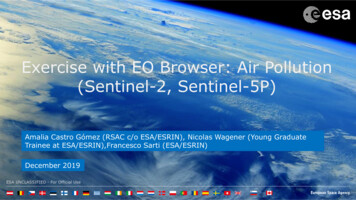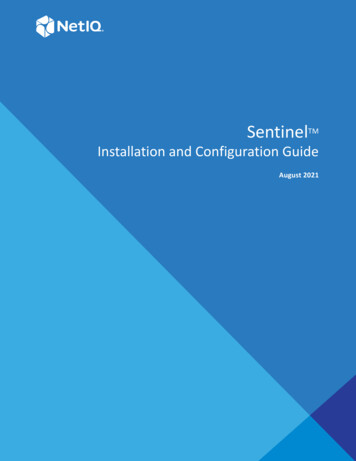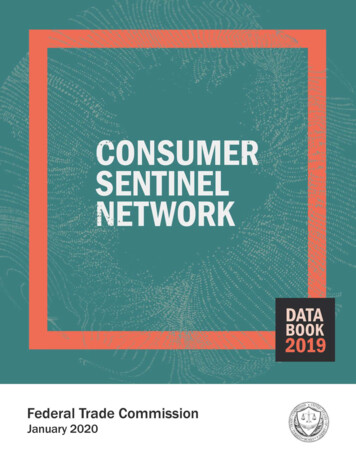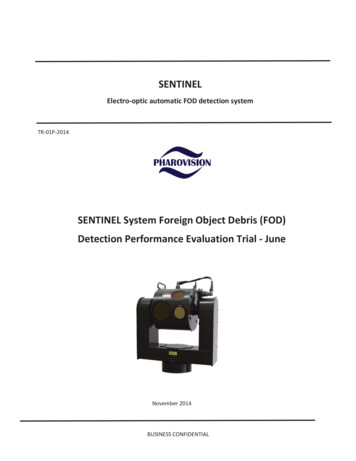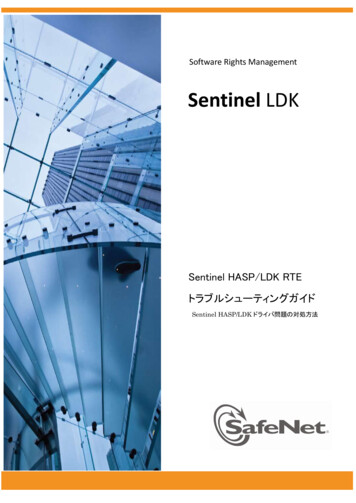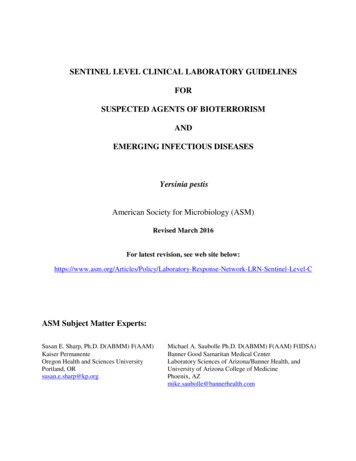
Transcription
SENTINEL LEVEL CLINICAL LABORATORY GUIDELINESFORSUSPECTED AGENTS OF BIOTERRORISMANDEMERGING INFECTIOUS DISEASESYersinia pestisAmerican Society for Microbiology (ASM)Revised March 2016For latest revision, see web site ry-Response-Network-LRN-Sentinel-Level-CASM Subject Matter Experts:Susan E. Sharp, Ph.D. D(ABMM) F(AAM)Kaiser PermanenteOregon Health and Sciences UniversityPortland, ORsusan.e.sharp@kp.orgMichael A. Saubolle Ph.D. D(ABMM) F(AAM) F(IDSA)Banner Good Samaritan Medical CenterLaboratory Sciences of Arizona/Banner Health, andUniversity of Arizona College of MedicinePhoenix, AZmike.saubolle@bannerhealth.com
ASM Sentinel Laboratory Protocol Working GroupVickie Baselski, Ph.D.University of Tennessee atMemphisMemphis, TNvbaselski@uthsc.eduBarbara Robinson-Dunn, Ph.D.Department of Clinical PathologyBeaumont Health SystemRoyal Oak, MIBRobinson-Dunn@beaumont.eduDavid Craft, Ph.D.Penn State Milton S. HersheyMedical CenterHershey, PAdcraft1@hmc.psu.eduMichael A. Saubolle, Ph.D.Banner Health SystemPhoenix, AZMike.Saubolle@bannerhealth.comPeter H. Gilligan, Ph.D.University of North CarolinaHospitals/ Clinical Microbiology andImmunology LabsChapel Hill, NCPGilliga@unch.unc.eduLarry Gray, Ph.D.TriHealth Laboratories andUniversity of CincinnatiCollege of MedicineCincinnati, OHlarry gray@trihealth.comMajor Todd Kijek, Ph.D.US Army Medical Research Institutefor Infectious DiseasesFt. Detrick, MDtodd.kijek@us.army.milMichael J. Loeffelholz, Ph.D.Department of PathologyUniv. Texas Medical BranchGalveston, TXmjloeffe@utmb.eduJudith C. Lovchik, Ph.D.Indiana State Department of HealthLaboratoriesIndianapolis, INjlovchik@isdh.IN.govScott W. Riddell, Ph.D.Department of PathologySUNY Upstate Medical UniversitySyracuse, NYRiddellS@upstate.eduSusan L. ShiflettMichigan Department ofCommunity HealthLansing, MIShiflettS@michigan.govAlice Weissfeld, Ph.D.Microbiology Specialists Inc.Houston, TXalice@microbiologyspecialists.comDavid Welch, Ph.D.Medical Microbiology ConsultingDallas, TXdfw@gmx.usMary K. York, Ph.D.MKY Microbiology ConsultantsWalnut Creek, CAmarykyork@gmail.comCoordinating Editor:James W. Snyder, Ph.D.University of LouisvilleLouisville, KYjwsnyd01@louisville.eduAdministrative SupportKimberly E. Walker, Ph.D.American Society for MicrobiologyWashington, DCkwalker@asmusa.orgAPHL Advisory CommitteePatricia Blevins, MPHSan Antonio Metro HealthDistrict Laboratorypatricia.blevins@sanantonio.govErin BowlesWisconsin State Laboratory ofHygienebowlesej@mail.slh.wisc.eduChristopher Chadwick, MSAssociation of Public y DeMartino MT(ASCP)SMState Hygienic Laboratory at theUniversity of Iowamary-demartino@uiowa.eduHarvey Holmes, Ph.D.Centers for Disease Control andPreventionhth1@cdc.govKara MacKeilAssociation of Public HealthLaboratorieskara.mackeil@aphl.orgChris Mangal, MPHAssociation of Public HealthLaboratoriesChris.Mangal@aphl.orgAmanda Moore, BSSouth Carolina Department ofHealth and EnvironmentalControlmooreal@dhec.sc.govJames Rudrik, Ph.D.Michigan Department ofCommunity HealthRudrikJ@michigan.govMaureen Sullivan, MPHMinnesota Department of Healthmaureen.sullivan@state.mn.us2
PREANALYTICAL CONSIDERATIONSI.PRINCIPLEA. IntroductionYersinia pestis is a nonmotile, slow-growing, facultative organism classified inthe family Enterobacteriaceae. It appears as plump, gram-negative coccobacillithat are seen mostly as single cells or pairs, which may exhibit bipolar stainingfrom a direct specimen if stained with Wright stains. This appearance has beenreferred to as “safety pin-like.”Y. pestis, the causative agent of plague, has a protracted history, beingdescribed in epidemics and pandemics since biblical times. In the Middle Ages,it was estimated to have killed up to 40% of the European population. In morerecent history, pandemic plague began in China in the 1860s. It spread to HongKong by the 1890s and subsequently was spread by ship rats to the Americas,Africa, and other parts of Asia (8). As recently as the beginning of the 20thCentury, India suffered more than 10 million deaths from plague, and in the1960s and 1970s, Vietnam was engrossed in a plague epidemic (1). Numerousreferences in art, literature, and monuments attest to the horrors and devastationassociated with the plague bacillus.B. Geographic distributionMore recently, during 2007-2011, a total of 23 human cases of plague from theU.S. were reported to the CDC (3).Plague is a zoonotic disease transmitted ordinarily from animals and theirinfected fleas. Most cases occur in the late winter to summer months and areassociated with flea contact (7).C. Diseases and Clinical PresentationHumans can acquire plague through the bite of infected fleas, direct contactwith contaminated tissue, or inhalation (4). The incubation period from flea biteto symptomatic disease is 2-10 days (5).Clinically, plague may present in bubonic, septicemic, and pneumonic forms(8). Bubonic plague is characterized by sepsis that is accompanied by thesudden onset of fever, chills, weakness, headache, and the formation of painfulbuboes (swelling of regional lymph nodes of the groin, axilla, or neck).Septicemic plague is similar to bubonic plague, but lacks the swelling of thelymph nodes. Pneumonic plague, the most deadly form of the disease and theform that can be transmitted rapidly, presents as fever and lymphadenopathywith cough, chest pain, and often hemoptysis. Secondary pneumonia fromhematogenous spread of the organisms can occur (secondary pneumonicplague). The organism can also occasionally be passed from human to humanby close contact as in primary pneumonic plague (2). Primary pneumonic3
plague is most likely the form that would be seen if Y. pestis were used in abioterrorism event. This is due to the high likelihood of aerosol delivery; thecommunicability of this form of the disease would make control of thisparticular agent even more problematic (6).The procedures described below are intended to rule out Yersiniapestis from human specimens when examining isolates fromcultures.D. CDC Case DefinitionA confirmed case is the isolation of Y. pestis from a clinical specimen, or afourfold or greater change in serum antibody titer to Y. pestis F1 spx?CondYrID 800&DatePub 1/1/1996).E. Presumptive DiagnosisA presumptive case of plague is an elevated serum antibody titer(s) to Yersiniapestis fraction 1 (F1) antigen (without documented fourfold or greater change) ina patient with no history of plague vaccination, or detection of F1 antigen in aclinical specimen by fluorescent assay.Note: sentinel clinical laboratories do not require registration with the SelectAgent Program to conduct diagnostic testing for Select Agents, both Tier I andnon-TierTesting for Select Agents may be performed by laboratories as long as thelaboratory destroys any residual specimen and destroys or transfers theconfirmed select agent with 7 days of receipt of a confirmedidentification. Reporting of all identified Select Agents is still required;laboratories will need to complete Form 4. If the organism is transferredfollowing identification, then the laboratory must also complete Form 2. Forfurther guidance and access to the necessary forms, consult with your designatedLRN Reference Laboratory or refer to the CDC Division of Select Agents andToxins website at www.selectagents.gov.As of October 2012, Yersinia pestis is considered a Tier 1 select agent because itpresents the greatest risk of deliberate misuse with most significant potential formass casualties or devastating effects to the economy, critical infrastructure, orpublic confidence. 9.htm)II. SAFETY CONSIDERATIONSA. These procedures should be performed in microbiology laboratories that useBiological Safety Level-2 precautions. All patient specimens should be handledas BSL-2 while wearing gloves and gowns and working in a biosafety cabinet(BSC). Subcultures should be performed in a Class II BSC. Plates should be4
taped shut, and incubated. All further testing should be performed only in theBSC. Because of the infectious nature of this organism, the appropriate LRNreference level laboratory should be consulted immediately if Y. pestis issuspected. See following reference pages 159-160 for additional information onsafety; BL.pdfB. Decontamination of laboratory surfaces is easily accomplished using a freshsolution of 10% bleach. Plates and specimens should be destroyed as directedby the LRN reference laboratory when the identification is confirmed.III.MATERIALS1. Mediaa. Sheep blood agar (SBA) or equivalentb. Selective agar: MacConkey (MAC) or Eosin methylene blue(EMB) agar2. Reagentsa. Gram stain reagentsb. Oxidased. Catalase (3% hydrogen peroxide)e. Indolef. Urease testg. Motility mediaNOTE: Separate procedures for the biochemical tests listed above are located inthe last section of the General Recommendations and Biochemical ProceduresSection.IV.QUALITY CONTROLPerform quality control of media and reagents according to package inserts, mostrecent CLSI document M22, and CLIA standards, using positive and negativecontrols. Do not use Yersinia pestis as a control organism, due to its infectiousnature. Examine culture plates for contamination, poor hemolysis, cracks, anddrying. Confirm the ability of CHOC to support growth of fastidious organisms.Quality control of biochemical tests using a positive and negative reacting organismshould generally be performed on each lot of reagent. For frequency of qualitycontrol, refer to manufacturer guidelines and state and federal regulations. Refer tothe biochemical test section for procedures and quality control organisms for eachtest.It is desirable for Sentinel laboratories to prescribe to a proficiency programdesigned to test the competency of Sentinel Laboratories in detection of agents ofbioterrorism. Should the laboratory identify a select agent, the laboratory isrequired to fill out and submit Form 4a within 90 days of receipt of the sample5
(http://www.selectagents.gov).V.SPECIMEN COLLECTIONA. Collection and Transport of Clinical Specimens for Laboratory Rule-Out TestingLower respiratory tract Transport specimens in sterile, screw-capped containers at roomtemperature. If it is known that material will be transported from 2-24 h aftercollection, then store and transport at 2-8 C. BloodTransport samples directly to the laboratory at ambienttemperature and place onto the blood culture instrumentDo not refrigerateFollow established laboratory protocols for processing blood cultures Aspirate, tissue or biopsyspecimen Swabs Submit tissue or aspirate in a sterile container.For small samples, add 1–2 drops of sterile normal saline to keep thetissue moist.Transport the sample at room temperature for immediate processing.Keep the specimen chilled if processing will be delayed ( 2 h).A swab of tissue is not recommended.However, if a swab specimen is collected, the swab should bereinserted into an appropriate transport package and sent to thelaboratory for immediate processing. Keep the specimen chilled ifprocessing will be delayed ( 2 h).B. Rejection of specimens1.Use established laboratory criteria for rejection of cultures2.Environmental or non-clinical samples are not processed by Sentinellaboratories; contact your designated LRN Reference Laboratorystate public health laboratory directly.ANALYTICAL CONSIDERATIONSVI. SPECIMEN PROCESSINGA. Blood1. Aseptically inoculate liquid blood culture bottles with maximum amount ofblood or body fluid per manufacturers’ instructions. Incubate at 35-37 C.2. Alternatively, follow the manufacturer’s instructions for the lysiscentrifugations method and inoculate pellet to BAP, CHOC and MAC.Incubate plates at 35-37 C in a humidified incubator with 5 to 10% CO2.B. For tissues, inoculate BAP, CHOC and MAC and incubate at 35-37 C in ahumidified incubator. Humidity may be maintained by placing a pan of water inthe bottom of the incubator or by wrapping the plates with gas permeable tape.6
VII. INCUBATION AND EXAMINATION OF CULTURESUse established inoculation and plating procedures for all specimen types. Tape platesshut to prevent inadvertent opening. Incubate at 25-28 C (optimal but optional)and/or 35–37 C (growth will be slower), in ambient air or 5% CO2 for 5 days.Plates should be held for up to 7 days if the patient has been treated with antibiotics priorto culture collections.VIII. CULTURE IDENTIFICATIONIf your laboratory uses Mass Spectrometry (MALDI-TOF or bioMérieux) forbacterial identification and if the manufacturer provides your facility with analternate tube extraction method, it is recommended that the resulting extract befiltered using a 0.2 µ (or less) filter. This additional step is recommended to reduce therisk of laboratory contamination with viable bacteria and spores.Using automated systems, including Mass Spectrometry (MALDI-TOF, bioMerieux)technology may result in exposure to dangerous pathogens, and could result inerroneous identification, Ex: Bacillus anthracis misidentified as B. cereus; Yersiniapestis misidentified as Y. pseudotuberculosis.A. Staining1.Gram stain characteristicsGram stained specimens containing Y. pestis often reveal Gram-negativerods, 1–2 μm x 0.5 μm, that are seen mostly in single cells or pairs. Theorganism may demonstrate short chains in liquid media.2.Wright or Giemsa stain characteristicsAlthough not normally performed in the microbiology laboratory, Wright orGiemsa stains (Figure 1) performed on peripheral blood or tissue byhematology or histopathology may reveal the bipolar staining characteristicsof Y. pestis, whereas the Gram stain may not. In patients with overwhelmingsepsis, bipolar staining rods may be detected in peripheral blood smears. It isuseful to note these characteristics in the event that hematology orhistopathology asks for a microbiology consult.7
B. Colony Morphology:Agar plates: Y. pestis grows as grey-white, translucent colonies, usually toosmall to be seen as individual colonies at 24 h. After incubation for 48 h,colonies growing on SBA are approximately 1-2 mm in diameter, gray-white toslightly yellow and opaque. Older cultures may have "Fried Egg" appearance.There is little or no hemolysis of the sheep red blood cells. At 48 h, Y. pestiswill grow as small, non-lactose fermenting colonies on MAC or EMB agar.8
Photo courtesy of APHL9
Photo courtesy of APHLC. Biochemical Reactions/Tests1. Use established laboratory procedures for catalase, oxidase,indole and urease tests (see also General Introduction,Recommendations and Biochemical Procedures).2. Commercial biochemical identification systems may misidentify theorganism and should not be used.E. Presumptive IdentificationAny isolate, from the respiratory tract, blood or lymph node, possessing themajor characteristics noted below should be suspected as Y. pestis. Also,refer to Table 1 and Flow Chart for rule-out protocols.a.b.c.d.Pinpoint colony at 24 h on SBANon-lactose fermenter, may not be visible on MAC or EMB at 24hOxidase, indole, urease negativeCatalase positiveNOTE: Full identification and susceptibility testing should not be performed.Confirmatory identification is made by an LRN Reference Level Laboratory; refer tohttps://emergency.cdc.gov/lrn/biological.asp.10
Table 1: Differentiation of other important Yersinia speciesYersina speciesOxidaseCatalaseUrea (35 C)*IndoleY. Y. enterocoliticanegativepositivepositivevariableY. frederikseniinegativepositivepositivepositiveY. kristenseniinegativepositivepositivevariableY. ruckerinegativepositivenegativenegativeY. pestisnegativepositivenegativenegative*Y. pseudotuberculosis and Y. enterocolitica give stronger reactions in urea agar orbroth when incubated at 25-28 C, but incubation at this temperature is not necessary todemonstrate urease production.11
Yersinia pestis Identification FlowchartMajor Characteristics of Yersinia pestisGram Stain Morphology: Gram-negative, plump rods, 0.5 x 1-2 µm.Colony Morphology: Slow growing at 35 C with either pinpoint colonies or no growth onBAP after 24 h; colonies after 48 h are 1-2mm, gray-white to slight yellow and opaque;nonlactose fermenter on MAC/EMB.Specimen is blood, sputum, or lymph node aspirateOxidase: NegativeCatalase: PositiveIndole: NegativeUrease: NegativeNoNot Yersinia pestis.Continue identificationper routine laboratoryprocedures. May beother Yersinia sppYesY. pestis not ruled out. Send to LRN Reference Level Laboratory.Report: Y. pestis cannot be ruled out; isolate referred to LRN ReferenceLevel Laboratory.WARNING: Some of the automated identification systems do not identify Y.pestis adequately. Y. pestis has been falsely identified as Y. pseudotuberculosis,Shigella, H2S negative Salmonella, Acinetobacter and Pseudomonas species.Note: Biochemical test procedures and quality control instructions can be found at the end of theGeneral Recommendation and Biochemical Testing Procedures document.12
POST ANALYTICAL CONSIDERATIONSIX.REPORTING, NOTIFICATION, AND TRANSFERA. Y. pestis is suspected and cannot be ruled out if the isolate fulfills the followingcharacteristics: Plump Gram negative bacilliSlow growing, at 35 with either pinpoint colonies or no growth on SBAafter 24 h; colonies after 48 h are 1-2mm, gray-white to slight yellow andopaque; non-lactose fermenter on MAC/EMBPositive for catalase and negative for oxidase, indole, and urease.B. Notifications and submission of cultures if Y. pestis cannot be ruled out byabove characteristics.1. Generate a report to the physician that Y. pestis species cannot be ruled out.2. Do not attempt full identification and susceptibility testing in the SentinelClinical Laboratory.3. Immediately notify your designated LRN Reference Laboratory, which willprovide the referring laboratory with guidance and recommendations forretaining the specimen or isolate and submission for confirmativeidentification.4. Preserve original specimens pursuant to a potential criminal investigationand transfer to your designated LRN Reference Laboratory in accordancewith state and local requirements. In particular, the appropriate material,including blood culture bottles, tubes and plates, and actual clinicalspecimens (aspirates, biopsies, sputum specimens) should be documented,and either submitted to the LRN Reference Laboratory or saved until theReference Laboratory confirms the identification.5. Do not ship specimens or cultures to LRN Reference Laboratories withoutprior arrangements.6. Notify other public health authorities (e.g. state public health departmentepidemiologist/health officer) as required by local and state communicabledisease reporting requirements. The state public health laboratory/statepublic health department will notify law enforcement officials (state andfederal), such as local FBI agents, as appropriate.7. Within the hospital setting, immediately notify the infection preventionistsand/or infectious disease service so that the patient can be treatedappropriately, infectious precautions can be taken, and a furtherinvestigation of the patient’s history can be made.8. Consult with the LRN Reference Level Lab about additional clinicalspecimens that may be submitted for testing9. Initiate documentation, showing the specimen identification control,notification and transfer to the designated LRN Reference Laboratory, anddocumentation of all plates and tube cultures, which will need to bedestroyed or transferred once identification has been completed.13
C. Sentinel Laboratories should consult with the designated LRN ReferenceLaboratory prior to or concurrent with testing, if Y. pestis species is requested bythe physician or a bioterrorist event is suspected. Obtain guidance from the statepublic health laboratory as appropriate (e.g., requests from local lawenforcement or other local government officials). FBI and state public healthlaboratory/state public health department will coordinate the transfer ofisolates/specimens to a higher-level LRN laboratory as appropriate.D. If Y. pestis species is ruled out, proceed with efforts to identify using establishedprocedures.E. If other cases are suspected or there is a laboratory exposure, collect samples tosubmit to the designated LRN Reference Laboratory for serological testing.X.SUMMARY/SPECIAL CONSIDERATIONSA. Antimicrobial susceptibility1. Antimicrobial susceptibility testing of Y. pestis is not appropriate forSentinel Laboratories to perform. Table 2 lists the appropriate antibiotics foruse against Y. pestis.Table 2: Antibiotics for use against Y. pestisAntibioticStreptomycinDoxycycline (starting)Doxycycline (repeat dose)GentamicinCiprofloxacinChloramphenicol (starting)Chloramphenicol (repeat dose)Dosage15 mg/kg IM daily200 mg IV100 mg IV twice daily5 mg/kg IM/IV daily500 mg oral BID25mg/kg QID15mg/kg QIDDuration10 daysOne dose10 days10 days10 daysOne day10 daysReference: m (accessed 3/25/13).14
B. Select Agent reporting and compliance1. Reporting of all identified Select Agents is still required, even thoughSentinel laboratories are not required to register under the Select AgentRule.2. The laboratory must complete Form 2 within one week (7 days) followingnotification of the confirmed identification. For further guidance and accessto the necessary forms, consult with your designated LRN ReferenceLaboratory or refer to the CDC Division of Select Agents and Toxinswebsite at www.selectagents.gov3. Reporting all identified Select Agents is required by completing Form 4 Awithin 7 days of confirmed identification. If the isolate is from a Proficiencytest sample, Form 4 B is to be completed within 90 days of receipt of thesample.4. Your designated LRN Reference Laboratory will advise you withcompletion of required forms (e.g., Forms 2, 3, and 4). Always refer towww.selectagents.gov for the latest guidance and versions of these forms.D. Destruction1. Once the identification of the isolate is confirmed, the Sentinel LaboratorySelect Agent regulations require that the residual specimen and cultures ofthe isolate be destroyed or transferred to an approved Select Agent entitywithin 7 days of confirmed identification. Your designated LRN ReferenceLaboratory must advise you on destruction or transfer of isolates.2. Generally all plates and clinical material that contain the organism should beautoclaved, incinerated on-site or submitted to the designated LRNReference Laboratory for disposal.3. Alternatively, contaminated items should be soaked in 10% bleach or 10%formalin for 24 hours.E. Packing and shipping1. Refer to the ASM Packing and Shipping Sentinel Guidelines.2. All materials sent to your designated LRN Reference Laboratory must beshipped in compliance with IATA and DOT regulationsLimitations1.Y. pestis will grow on general nutrient-rich media but its growth rate isslower than that of most other bacteria; therefore, its presence may bemasked by other organisms that replicate faster.2. The bipolar appearance of cells following Wright or Giemsa staining is notunique to Y. pestis. Other Yersinia spp., enteric bacteria, and other Gramnegative organisms, particularly Pasteurella spp., can exhibit the samestaining characteristic.3. Characteristic clumped growth in unshaken broth culture is not an exclusivefeature of Y. pestis. Some Y. pseudotuberculosis and Streptococcus15
pneumoniae can exhibit the same growth features.4. Some of the automated identification systems do not identify Y. pestisadequately. Y. pestis have been falsely identified as Y. pseudotuberculosis,Shigella, H2S-negative Salmonella, or Acinetobacter (9).5. Because of the limitations in identification of Y. pestis using methodstypically found in microbiology laboratories, a high level of suspicion isessential. For blood isolates in particular, isolation of any Yersina spp orH2S-negative Salmonella may be an indication to evaluate the clinicalcondition of the patient to determine if plague is a possibility.6. Additionally, isolation of Shigella from blood is highly unlikely as is isolationof Acinetobacter from a case of severe community-acquired pneumonia orsepsis, and should immediately raise suspicion.REFERENCES1. Butler T. 1983. Plague and other Yersinia infections, p. 163–188. In: Greenough WB III,Merigan TC (eds), Current topics in infectious diseases. Plenum Medical Book andCompany, New York.2. Campbell G.L., D.T. Dennis. 1998. Plague and other Yersinia infections, p. 975–983. In: Kasper DL, et al., (ed). Harrison’s principles of internal medicine. 14th ed.McGraw-Hill, New York, NY.3. CDC. 2012. Notifiable disease and mortality rates. MMWR Mortal Wkly Rep 61(33);ND452-ND-465.4. Gage K.L. 1998. Plague. In: L. Colliers, A. Balows, M. Sussman, W. J. Hausles (ed).Topley and Wilson’s microbiology and microbiological infections, Vol. 3, p. 885-903.Edward Arnold Press, London.5. Gage, K.L., D.T. Dennis, K.A. Orloski, et al. 2000. Cases of cat-associated humanplague in the western US, 1977-1998. Clin Infect Dis; 30:893-900.6. Inglesby T.V., D.T. Dennis, D.A. Henderson J.G. Bartlett, M.S. Ascher, E. Eitzen,A.D. Fine, A.M. Friedlander, J. Hauer, J.F. Koerner, M. Layton, J. McDade, M. T.Osterholm, T. O'Toole, G. Parker, T.M. Perl, P.K. Russell, M. Schoch-Spana, K.Tonat. 2000. Plague as a biological weapon: medical and public health management.Working Group on Civilian Biodefense. JAMA, 283: 2281-2290.7. Lowell, L.L., D.M. Wagner, B. Atshaber, et al. 2005. Identifying sources of humanexposure to plague. J Clin Microbiol 43:650-656.8. Perry R.D., J.D. Fetherston. 1997. Yersinia pestis—etiologic agent of plague. ClinMicrobiol Rev. 10:35–66.9. Wilmoth B.A., M.C. Chu, T.J.Quan. 1996. Identification of Yersinia pestis by BBLCrystal Enteric Nonfermentor identification system. J Clin Microbiol, 43:2829-2830.16
REFERENCE ADDENDUM1. Keller, P. M., V. Bruderer, and F. Müller. 2016. Restricted Identification of ClinicalPathogens Categorized as Biothreats by MALD-TOF Mass Spectrometry. J. Clin.Microbiol. 54:816.2. Tracz, D. M., K. Antonation, and C. R. Corbett. 2015. Verification of a matrix-assistedlaser desorption ionization-time of flight mass spectrometry method for diagnosticidentification of high-consequence bacterial pathogens. J. Clin. Microbiol. 54:764-767.3. Tracz, D. M., S. J. McCorrister, P. M. Chong, D. M. Lee, C. R. Corbett, and G. R.Westmacott. 2013. A simple shotgun proteomics method for rapid bacterialidentification. J. Microbiol. Methods. 94: 54 -57.4. Tracz, D. M., S. J. Mcorrister, G. R. Westmacott, and C. R. Corbett. 2013. Effect ofgamma radiation on the identification of bacterial pathogens by MALDI-TOF MS. J.Microbiol. Methods. 92: 132 – 134.17
IV. QUALITY CONTROL . Perform quality control of media and reagents according to package inserts, most recent CLSI document M22, and CLIA standards, using positive and negative controls. Do not use Yersinia pestis as a control organism, due to its infectious nature. Examine culture plates for contamination, poor hemolysis, cracks, and drying.
